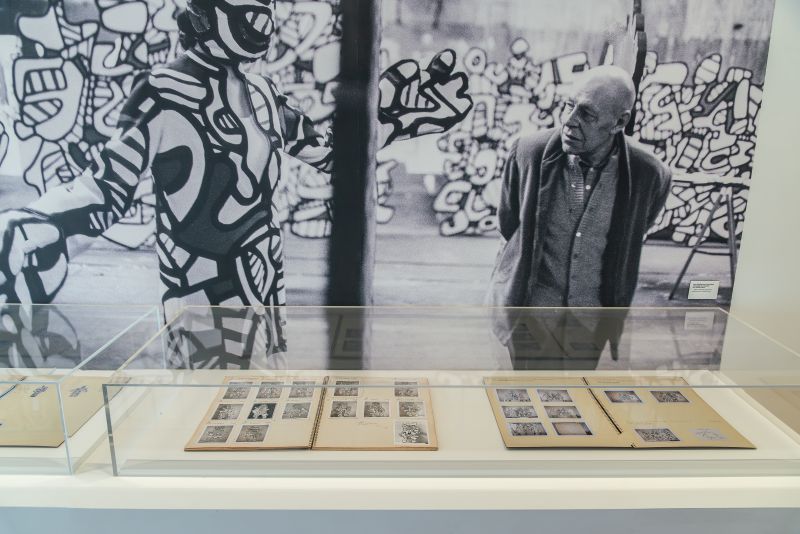Rétrospective d’un « Dubuffet architecte »
The exhibition
The Fondation Dubuffet, created by the artist himself, is currently paying tribute to the unique models of L'Hourloupe in a brand new exhibition: ‘Dubuffet Monumental’. The project retraces the evolution of this period, dressing up the building with its red, blue and black solids and stripes on a white background.
‘Dubuffet Monumental’.
Daniel Abadie, curator at the Musée National d'Art Moderne and director of the Jeu de Paume, coined the phrase ‘Dubuffet architecte’ at the exhibition ‘Jean Dubuffet : Édifices, projets et maquettes d'architecture’ exhibition at the Musée des Arts décoratifs in 1968. It is this ‘Dubuffet architect’ that interests curators Sophie Webel and Déborah Lehot-Couette, as they present a selection of models and archives in a chronological and thematic tour.
The exhibition offers a detailed overview of his creative work, from his first commission for an architectural piece in December 1968, with the Group of Four Trees for Rockefeller, to the Welcome Parade in 2008 in a duo with Ieoh Ming Pei for the prestigious National Gallery in Washington. The tree motif represents ‘nature reinvented according to the principles of L'Hourloupe’, explains the foundation, while projects such as Welcome Parade and the show Coucou Bazar feature disarticulated, almost boneless figures. Coucou Bazar also finds continuity in what the artist calls ‘rigged photographs’. Jean Dubuffet points out in Bâtons rompus that ‘photographic images [...] in no way provide the appearance of objective reality’. Despite this aversion to the medium, he did use it, integrating his projects for architectural sculptures into photographs of urban space (a tower, for example, standing on the Pont de la Tournelle in Paris, with a view of Notre Dame behind it).
‘Dubuffet monumental’ is not just an exhibition, but the result of a ground-breaking publication, “Sculptures monumentales, Tour aux figures et autres”, the thirty-ninth instalment of the Catalogue des travaux de Jean Dubuffet. The book, a veritable ‘Bible’ for all fans of this great artist and of L'Hourloupe, lists all the architectural sculptures made from models since 1969.
Outside the walls.
But the Foundation doesn't stop at Paris. The famous Tour aux figures can be found on the Île Saint-Germain in Issy-les-Moulineaux. It also has a second address in Périgny-sur-Yerres, where most of the artist's collections are on display. This is also where the Closerie Falbala, listed as a Historic Monument in 1998, is located. In the grounds of the Closerie, Dubuffet created the Villa Falbala with its Cabinet lologique. This ensemble represents the apogee of L'Hourloupe.
The Parisian gallery Lelong & Co is showing ‘Jean Dubuffet, Banc-salon et Cerfs-volants’ until 30 April. And for the more well-travelled among you, New York's Pace Gallery is presenting ‘Dubuffet: The L'Hourloupe Cycle’ until 26 April!
Dubuffet Monumental, Fondation Dubuffet, Paris, until 11 July 2025.
Ariane Rogel.
‘Dubuffet Monumental’.
Daniel Abadie, curator at the Musée National d'Art Moderne and director of the Jeu de Paume, coined the phrase ‘Dubuffet architecte’ at the exhibition ‘Jean Dubuffet : Édifices, projets et maquettes d'architecture’ exhibition at the Musée des Arts décoratifs in 1968. It is this ‘Dubuffet architect’ that interests curators Sophie Webel and Déborah Lehot-Couette, as they present a selection of models and archives in a chronological and thematic tour.
The exhibition offers a detailed overview of his creative work, from his first commission for an architectural piece in December 1968, with the Group of Four Trees for Rockefeller, to the Welcome Parade in 2008 in a duo with Ieoh Ming Pei for the prestigious National Gallery in Washington. The tree motif represents ‘nature reinvented according to the principles of L'Hourloupe’, explains the foundation, while projects such as Welcome Parade and the show Coucou Bazar feature disarticulated, almost boneless figures. Coucou Bazar also finds continuity in what the artist calls ‘rigged photographs’. Jean Dubuffet points out in Bâtons rompus that ‘photographic images [...] in no way provide the appearance of objective reality’. Despite this aversion to the medium, he did use it, integrating his projects for architectural sculptures into photographs of urban space (a tower, for example, standing on the Pont de la Tournelle in Paris, with a view of Notre Dame behind it).
‘Dubuffet monumental’ is not just an exhibition, but the result of a ground-breaking publication, “Sculptures monumentales, Tour aux figures et autres”, the thirty-ninth instalment of the Catalogue des travaux de Jean Dubuffet. The book, a veritable ‘Bible’ for all fans of this great artist and of L'Hourloupe, lists all the architectural sculptures made from models since 1969.
Outside the walls.
But the Foundation doesn't stop at Paris. The famous Tour aux figures can be found on the Île Saint-Germain in Issy-les-Moulineaux. It also has a second address in Périgny-sur-Yerres, where most of the artist's collections are on display. This is also where the Closerie Falbala, listed as a Historic Monument in 1998, is located. In the grounds of the Closerie, Dubuffet created the Villa Falbala with its Cabinet lologique. This ensemble represents the apogee of L'Hourloupe.
The Parisian gallery Lelong & Co is showing ‘Jean Dubuffet, Banc-salon et Cerfs-volants’ until 30 April. And for the more well-travelled among you, New York's Pace Gallery is presenting ‘Dubuffet: The L'Hourloupe Cycle’ until 26 April!
Dubuffet Monumental, Fondation Dubuffet, Paris, until 11 July 2025.
Ariane Rogel.
When
12/02/2025 - 11/07/2025
.jpg)
